Leaf Feeders
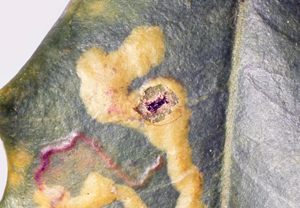
Jim Baker, North Carolina State University, Bugwood.org
Native holly leaf miner feeds on American and Japanese holly but only lays eggs on American holly. Damage is caused by the mining of the yellow maggot of a small fly. Damage initially appears as a dark brown spot on the leaf which turns into a long blotch by later winter. Larvae start by mining in a serpentine fashion and mines become wider as feeding continues. Adult females are active in May and make small puncture wounds in leaves with their egg laying tubes. Male and female flies feed on sap that escapes from the wounds. Collection and destruction of fallen leaves can reduce the severity of future infestations.
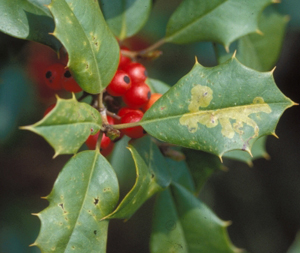
Daniel Herms, The Ohio State University, Bugwood.org
The holly leafminer feeds only on English, Oregon or European holly. Emergence of adult flies from pupae begins during the blossoming period in the spring. Female flies will lay eggs in the midrib of the leaf. Newly hatched larvae will feed between the upper and lower layers of leaf cells. First signs of damage will be noticed later in summer (August) as small red spots. By the middle of winter the feeding by the larva has been extensive enough to cause the characteristic mine of this species.
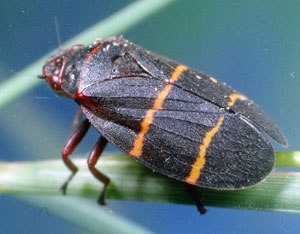
Clemson University - USDA Cooperative Extension Slide Series, Bugwood.org
Twolined spittlebug adults look like planthoppers or cicadas. They have all black bodies with red eyes and normally have two orange lines crossing their back. The nymphs live in a mass of frothy spittle that is nestled into grasses. Adults feed on the undersides of holly leaves causing mottling from above.
Sap Feeders
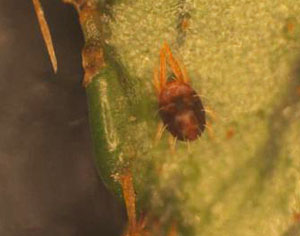
Tracy Wootten, University of Delaware, Bugwood.org
Southern red mites are tiny (1/50 inch) arthropods with a dark red or brown color. They live on the underside of leaves and use needle-like mouthparts to remove the contents of individual cells. This produces tiny white to yellow spots on leaves, sometimes called flecking or bronzing. Infestations are usually most serious during cool periods of spring and fall.
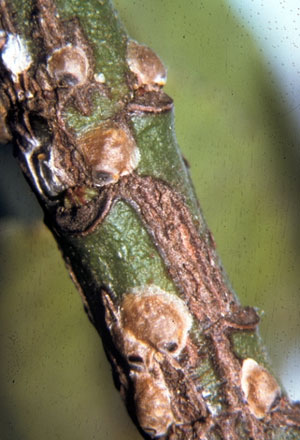
United States National Collection of Scale Insects Photographs , USDA Agricultural Research Service, Bugwood.org
Greedy scale are small armored scales that create a conical shaped cover. As they grow and shed their old exoskeleton, it is incorporated into the wax that makes up the shield. Eventually this results in a characteristic off-center nipple or dot on the outer coating. There are often concurrent overlapping generations on plants.
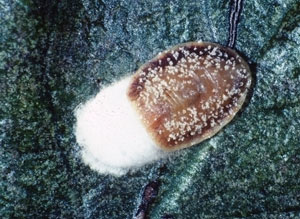
John A. Davidson, Univ. Md, College Pk, Bugwood.org
Cottony camellia scale adult females are about 1/8 inch long but they produce long white egg masses behind them, so they appear much larger. These egg masses are laid on the undersides of leaves and crawlers will hatch and feed throughout the summer. Their feeding results in large quantities of honeydew, which in turn leads to development of black sooty mold.
Root Feeders
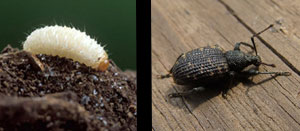
grub: Peggy Greb, USDA Agricultural Research Service, Bugwood.org ;
adult: Cheryl Moorehead, Bugwood.org
Black vine weevil grubs are white legless larvae with yellow brown or red heads that live in the soil and feed on plant roots. Moderate root feeding may cause plants to show signs of drought stress. Girdling can occur and nutrient transmission is disrupted, occasionally leading to death of the plant. The adults (0.5 inch long) are dark snout beetles that may chew crescent-shaped holes in leaves while feeding at night. Normally there is one generation per year with the larva overwintering. Pupation and adult emergence occurs in the spring. Sometimes adults may overwinter which can result in damage occurring from larvae earlier in the season.